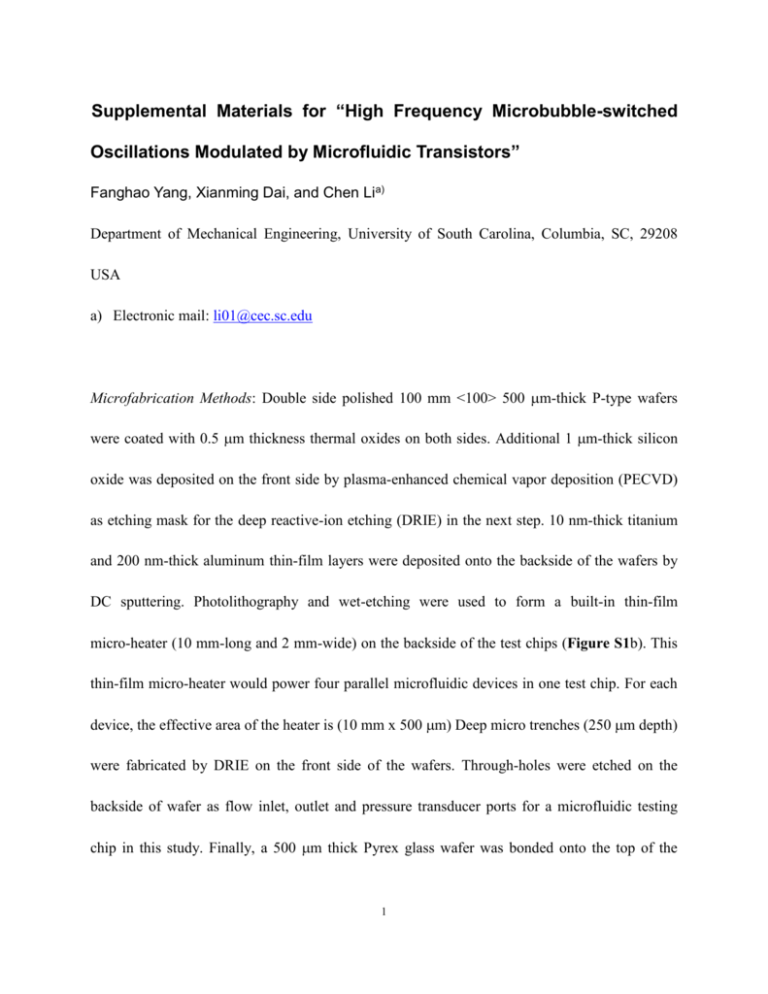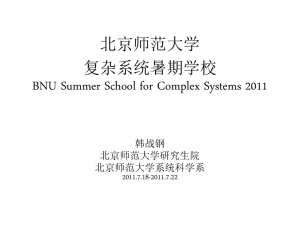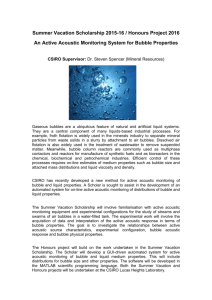Supplemental materials of microfluidic oscillator for
advertisement

Supplemental Materials for “High Frequency Microbubble-switched Oscillations Modulated by Microfluidic Transistors” Fanghao Yang, Xianming Dai, and Chen Lia) Department of Mechanical Engineering, University of South Carolina, Columbia, SC, 29208 USA a) Electronic mail: li01@cec.sc.edu Microfabrication Methods: Double side polished 100 mm <100> 500 m-thick P-type wafers were coated with 0.5 m thickness thermal oxides on both sides. Additional 1 m-thick silicon oxide was deposited on the front side by plasma-enhanced chemical vapor deposition (PECVD) as etching mask for the deep reactive-ion etching (DRIE) in the next step. 10 nm-thick titanium and 200 nm-thick aluminum thin-film layers were deposited onto the backside of the wafers by DC sputtering. Photolithography and wet-etching were used to form a built-in thin-film micro-heater (10 mm-long and 2 mm-wide) on the backside of the test chips (Figure S1b). This thin-film micro-heater would power four parallel microfluidic devices in one test chip. For each device, the effective area of the heater is (10 mm x 500 m) Deep micro trenches (250 m depth) were fabricated by DRIE on the front side of the wafers. Through-holes were etched on the backside of wafer as flow inlet, outlet and pressure transducer ports for a microfluidic testing chip in this study. Finally, a 500 m thick Pyrex glass wafer was bonded onto the top of the 1 wafers as a transparent window for visualization study. Both sides of the microfluidic testing chip are shown in Figure S1. Measuring Methods: Two-phase microbubble-switched oscillations were tested and visualized in an established two-phase test platform. The visualization system consists of a high-speed camera (Phantom V 7.3) with 256 x 256 pixels at approximate 40,000 FPS (frames per second) and an Olympus microscope (BX-51) with 400X amplifications. Pressure drop data were collected by two Omega PX01-C1 pressure transducers with ±0.05% linearity and repeatability. All original points of transducer output were calibrated under 1 atmosphere prior to measurements. The sampling rate of transient pressure drop data was 1k Hz. Uniform input heat flux was supplied by a digital power supply through a built-in thin-film heater on the backside of a microfluidic test chip. Pressurized nitrogen gas served a constant-pressure pump to supply DI water through a needle valve into a test chip. The mass and heat fluxes were precisely controlled in the test platform. Mass fluxes were measured by Sensiron ASL1600 flowmeter with 0.03 kg m-2 s-1 resolution. All pressure drop data, mass and heat flux data were automatically recorded by a real-time digital data acquisition system. 2 FIG. S1. Top-view of two sides of a microfluidics test chip. (a) The gray area in the front side of the test chip is the solid wall or bonding area. The light blue indicates wet area. Thermal isolation gaps are used to reduce heat loss. (b) The green area in the back side of the test chip is a built-in aluminum thin-film heater. Two contact pads are designed to achieve great electric contact with pogo-pins. Testing System: The front side and the back side of testing chip are shown in Figure S1. And a testing package module is shown in Figure S2b and S2c. This testing package module could provide reliable hydraulic and electrical connections to microfluidic chips. So that oscillation of pressure drop can be precisely measured in real-time. Several pogo-pins are used to ensure perfect electric contact between pins and the metal pads on the backside of microfluidic chips. Hydraulic ports are sealed by micro rubber O-rings. The schematic map of testing platform as shown in Figure S2 illustrates functions and connections of major components in the system. Blue wires show the hydraulic connections through stainless steel tubing. The red lines denote gas tubing. Green wires represent electrical wires/connections. The yellow line indicates the 3 optical path for visualization study. FIG. S2. The two-phase testing platform. (a) The picture of the testing platform. (b) An exploded 3D model of testing package module, which provide hydraulic and electrical connections. (c) A picture of the testing package module. (d) Schematic map of the testing platform. Data Reduction: The electrical power of microheater, P, is calculated as P V I , where, V is , is defined in the voltage on the micro-heater, and I is the current. The effective heat flux, qeff ( P Qloss ) / Ae . Here Qloss is the heat loss and Ae is the effective area of our study as: qeff heating. The heat loss Qloss includes the natural convection heat transfer between testing system and the ambient environment. The heat loss is a function of temperature of the micro-heater as shown in Figure S3. 4 FIG. S3. Heat losses as a linear function of temperature of the heater. Correlation coefficient is larger than 0.99. The transient pressure drop oscillation posc in Figure 4 is derived by Eq. (2), posc (t ) p(t ) p (1) ,where p is transient pressure drop as a function of time t and p is the averaged pressure drop in relative long time (4 minutes). Detailed flow resistance modeling during bubble growing/collapsing (BGC) processes is described in this section. The high frequency periodic flow oscillation is primarily governed by the non-linear bubble dynamic process in this study. A model of two-phase flow resistance has been established to estimate the magnitude and frequency of HF-BGC in terms of flow resistance. Each microchannel is modeled as an individual unit. A system-level modeling is coupled through the cross-junction from two side-channels and a main-channel. Transient flow resistance during a 5 period of flow oscillation inside a confined microchannel has been decomposed into several states in a time domain. As shown in Figure 2, flow structures have been characterized to five regimes, each of which has its own flow resistance model for individual regime. Before bubble nucleation, the flow in microchannel is single-phase flow. For single-phase flow inside microchannels, the Reynolds number, Re, is 2300, in this study. The Hagen-Poiseuille law is applicable and adopted to estimate the hydraulic resistance, R1h 8 L / rh2 Ac , where is the dynamic viscosity, L is the length of a microchannel, rh is the hydraulic radius and Ac is the cross-section area. Overall, for a constant volumetric flow rate Q, the pressure drop Δp is calculated as p Q R , where, R is the overall flow resistance of a microchannel. Flow oscillation resistances are resulted from BGC process inside microchannels and can be categorized into several typical flow regimes. Without considering the flow acceleration, the overall hydraulic resistance of a single channel R is simplified to three components: the hydraulic flow resistance in single phase flow R1h , the additional hydraulic flow resistance caused by bubbles R2h and the capillary pressure induced by confined bubbles when attaching to walls R3h . To simplify this complicated problem, we use a single-bubble model as shwn in Eq. (2), which assumes that only one confined bubble in a microchannel. This assumption has been validated by the visualization study: there is only one confined bubble in side-channels and main-channels during the HF oscillation. 6 R1h , t t0 R R (t ), t t t 1h 2h 0 1 R(t ) R1h R3h (t ), t1 t t2 R1h R3h (t2 ), t2 t t3 (2) R is a non-linear function of time t in a period of BGC. The period is estimated by t t3 t0 . A confined bubble grows and reaches the walls in t1 t1 t0 during bubble growing period. Then, the liquid film formed between vapor bubble and solid wall is evaporating and drying out in time t2 t2 t1 . After that, the bubble lasts a short time t3 t3 t2 until the confined bubble collapses due to the direct condensation. The time of ultrafast condensation, which is approximately 0.2 ms and only a small fraction of a total period at approximately 5 ms, is neglected because current model seeks to capture the transient flow resistance during the BGC process. According to Choi et al’s modified model1 , the hydraulic resistance of confined bubble is estimated by Eq. (3) as following R2 h (t1 ) (0.07 106.8 / Re) l v 2 / Q (3) where Reynolds number is defined as Re Dh l v / , and Dh is the hydraulic diameter, l is the mass density of liquid phase, v is the superficial velocity of fluid. This empirical equation fits most cases of different Re from 50 to 700. The flow resistance resulted from capillary pressure or surface tension force on the two ends of a bubble attaching on the walls is derived in Eq. (4) R3h (t2 ) 4 / (QDh ) (4) where γ is the surface tension. The time of bubble growing prior to directly attaching on solid 7 walls can be calculated from several proposed models2 as described in Eq. (5) t1 rh2 / ( l Ja 2Cb 2 ) (5) where, l is the liquid thermal diffusivity. Jacob number is Ja l clTsat / v h fg and Cb is a constant with value from 4 / to 12 / . An additional critical time during the thin liquid film evaporation is calculated as t2 d film l h fg / q (6) where, q is the heat flux. h fg is the latent heat. The thickness of liquid film d film is estimated in Eq. (7) as below d film 0.67 DhCa2/3 / (1 3.35Ca2/3 ) (7) Eq. (7) is called Taylor’s law from fitted experimental data3. Ca is the Capillary number and estimated by Ca 0.445 / . Finally, t3 t t3 , which is primarily governed by the critical size of bubble collapsing and has not been well studied in a micro-domain, is estimated from the visualization study due to the complex physics. According to high speed camera videos, t N f / N FPS , here N f is the average number of frames in an oscillation period and N FPS is number of Frames Per Second (FPS). A numerically fitted equation is developed to estimate the transient flow resistance such that it can be conveniently calculated during a period. As a switched oscillator, a logistic function is adopted. The least square curve fitting method has been employed to calculate coefficients. R(t ) R1h R3h (t2 ) / (1 ae bt ) (8) where, a and b are coefficients, which are case sensitive. Eventually, this equation was used to 8 generate curves in the Figure 4c. It shall be noted that this is one component channel flow-resistance function within a period t during HF-TPOs. The transient flow resistance is described by Eq. (8). The lumped model at system level modeling is illustrated in Figure 4a. The high-aspect-ratio restrictor is designed to against the overall resistance of main channel and side channel. As a result, the high resistance resulting from a restrictor, R1 , is nearly constant during the two-phase oscillations4. Except for R1 , each “flow resistor” in Figure 4c is treated as a periodic function during a BGC process. Moreover, these functions are non-synchronous so that there are several measured time constants between each individual BGC process in side-channels. R21 (t ) , R22 (t ) and R3 (t ) are transient flow resistances in side-channels and main channel, respectively. Resistances are treated as periodic functions as following: R21 (t ) R2 (t N / f 2 ) and R22 (t ) R21 (t td 2 ) as shown in Figure 4b, where, N is a natural number. Oscillation frequency in a side channel is measured by high speed camera as: f 2 N FPS / N f . Two side channels are non-synchronous with time difference, td 2 . According to observations on bubble dynamics as illustrated in Figure 2 and Figure S4, the bubbles inside the main-channels collapse as a result of jetting flow induced by the bubbles collapsing in side-channels. A delay time, td 1 l / vw , is estimated as length l divided by rewetting velocity, vw , which was measured by high speed camera. Once component flow resistance in individual channels has been modeled as a function of time, a microfluidic transistor model can be developed to explain the interactions between each independent component in this system. As transistor-like function at the cross-junction, a 9 corresponding negative correlation between the flow resistance R3 (t ) from “source” to “drain” and the local pressure p gate at “gate”, which is proposed as a logistic function, R3 (t ) R1h R3h (t2 ) exp( t ( pbubble pgate )) / (1 aebt ) , according to video research at Figure 2 and Figure 3; where, R (t ) is the function as Eq. (7) with specific coefficient, pbubble is the local pressure inside the confined bubble and is a positive constant. This model indicates that the bubble collapsing process in main channels due to the direct condensation always leads a sharp local pressure reduction and consequently, results in accelerated fluid flow through the "gate" on the walls. In this simplified modeling, is a large positive value (e.g. 1000) to indicate the accelerated process of bubble collapse in main channel. This problem is simplified because of the complicated mechanisms of phase change and critical diameter for bubble collapsing, however, the time period of bubble collapsing is much shorter than the total period time and thereof is negligible. It shall be noted that this problem is not a critical part of the model. The pressure drop due to the bubble collapsing process is roughly estimated by Bernoulli’s equation: pgate pbubble (v2j vs2 ) / 2 , where is the liquid density, v j is the velocity of fluid jetting and vs is average superficial velocity. Finally, this model is programmed in MATLAB. The system-level pressure drop oscillation function of time is plotted in Figure 4d and compared with experimental data. Great agreement has been achieved. 10 FIG. S4. Bubbles grow, attach to walls and collapse in side-channels. Arrows show the local flow directions. The white rectangle highlights a confined bubble, which is dark black shadow in a side channel under optical microscope. From 0 ms to 1.7 ms, two confined bubbles rapidly grow in side-channels and induce reversal flows into sub-cooled upstream. The direct contact between the sub-cooled water and bubbles results in condensation and hence the collapse of the confined bubbles at 4.2 ms. The additional pressure drop established by collapsed bubbles accelerates the sub-cooled liquid, which is pumped into the main-channel through the cross-junction. (Refer to Movie S3) Movies S1 A close look at the HF bubble growth/collapse processes in the main-channel near the cross-junction. Flow oscillations (pulses) in side-channels cause the bubble collapse in the main-channel. The working condition: mass flux at 224 kg m-2 s-1 and heat flux on wall at 111.7 W cm-2. This video are recorded at FPS 14035 and replayed at FPS 5. Movies S2 11 The interactions of high frequency bubble growth/collapse processes in the side-channels and main-channel. Bubbles nucleate and grow in the side-channel until they are confined by walls. Due to guidance of the converging gate, a confined bubble in side-channels expands only towards upstream, where the bubble contacts with sub-cooled fluids at a velocity and rapidly collapses due to the direct and promoted condensation. The jetting flow, which is pumped by the pressure gradient established by the bubble collapse in side-channels, introduces the direct condensation on the large confined bubble and causes the bubble collapse in the main-channel. The working condition: mass flux at 150 kg m-2 s-1 and heat flux on wall at 184 W cm-2. This video are recorded at FPS 14035 and replayed at FPS 5. Movies S3 Fluid flows in the inlet area. The reverse flows due to bubble expansion in the side-channels are recorded. Rapidly growing bubbles expand into the sub-cooled upstream, directly condense and eventually collapse. The resulted pressure gradient pumps sub-cooled fluid into main-channels. Due to light refractive index difference of two phases (liquid and gas), moving dark areas are confined bubbles in this video while bright areas are liquid. The working condition: mass flux at 298 kg m-2 s-1 and heat flux on wall at 150 W cm-2. This video are recorded at FPS 14035 and replayed at FPS 5. References 1 C. W. Choi, D. I. Yu, and M. H. Kim, Int. J. Heat Mass Transf. 53 (23-24), 5242 (2010). 2 E. Ory, H. Yuan, A. Prosperetti, S. Popinet, and S. Zaleski, Phys. Fluids 12 (6), 1268 (2000); D. B. R. Kenning, D. S. Wen, K. S. Das, and S. K. Wilson, Int. J. Heat Mass Transf. 49 (23-24), 4653 (2006). 3 P. Aussillous and D. Quere, Phys. Fluids 12 (10), 2367 (2000). 4 A. Kosar, C. J. Kuo, and Y. Peles, J. Heat Transf.-Trans. ASME 128 (3), 251 (2006). 12







